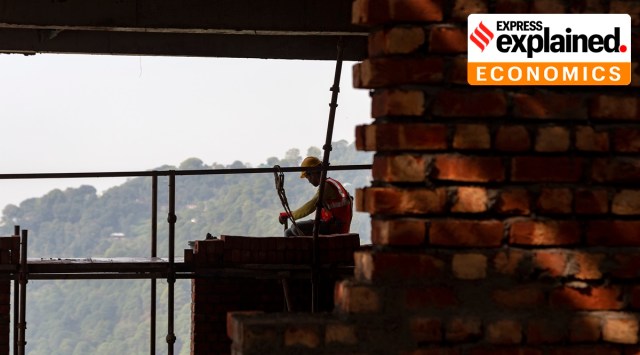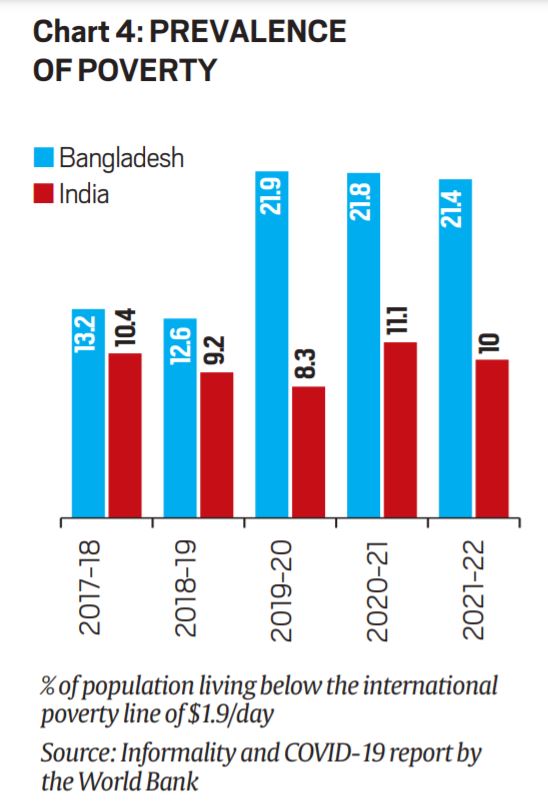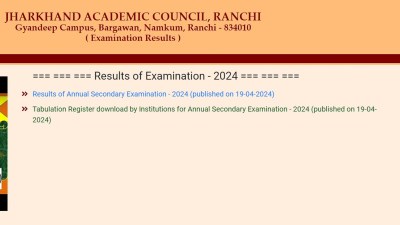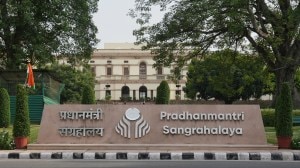- India
- International
Explained: Why has the comparison between India, Bangladesh per capita GDP got so much attention?
In IMF’s latest Economic Outlook, Bangladesh has overtaken India in GDP per capita. While Bangladesh has indeed made strides, its smaller population helps lift this metric. What else matters, what can happen now?
 A man works at a construction site in Dharmsala, Tuesday, Oct. 13, 2020. (AP Photo: Ashwini Bhatia)
A man works at a construction site in Dharmsala, Tuesday, Oct. 13, 2020. (AP Photo: Ashwini Bhatia)The International Monetary Fund’s latest update on the World Economic Outlook released on Wednesday. In the IMF’s estimation, in 2020, growth of India’s gross domestic product (GDP) will witness a contraction of over 10%. This more than doubles the level of contraction — from 4.5% — that the IMF had projected for India just a few months ago.
But more than the sharp contraction, what has caught everyone’s attention is that in 2020, the per capita income of an average Bangladeshi citizen would be more than the per capita income of an average Indian citizen.
How did this happen? Isn’t India one of the world’s biggest economies?
Typically, countries are compared on the basis of GDP growth rate, or on absolute GDP. For the most part since Independence, on both these counts, India’s economy has been better than Bangladesh’s. This can be seen from Charts 1 and 2 that map GDP growth rates and absolute GDP — India’s economy has mostly been over 10 times the size of Bangladesh, and grown faster every year.
 Source: World Economic Outlook Report, 2020
Source: World Economic Outlook Report, 2020
However, per capita income also involves another variable — the overall population — and is arrived at by dividing the total GDP by the total population. As a result, there are three reasons why India’s per capita income has fallen below Bangladesh this year.
*The first thing to note is that Bangladesh’s economy has been clocking rapid GDP growth rates since 2004. However, this pace did not alter the relative positions of the two economies between 2004 and 2016 because India grew even faster than Bangladesh. But since 2017 onwards, as Chart 1 shows, India’s growth rate has decelerated sharply while Bangladesh’s has become even faster.

*Secondly, over the same 15-year period, India’s population grew faster (around 21%) than Bangladesh’s population (just under 18%).
The combined effect of these two factors can be seen in how the per capita GDP gap had closed considerably even before Covid-19 hit (Chart 3). Bangladesh’s per capita GDP was merely half of India’s in 2007 — but this was just before the global financial crisis. It was roughly 70% of India’s in 2014 and this gap closed rapidly in the last few years.
*Lastly, the most immediate factor was the relative impact of Covid-19 on the two economies in 2020. While India’s GDP is set to reduce by 10%, Bangladesh’s is expected to grow by almost 4%. In other words, while India is one of the worst affected economies, Bangladesh is one of the bright spots.
Has this ever happened earlier?
Yes. In 1991, when India was undergoing a severe crisis and grew by just above 1%, Bangladesh’s per capita GDP surged ahead of India’s. Since then, India again took the lead.
Is India expected to regain the lead again?
Yes. The IMF’s projections show that India is likely to grow faster next year and in all likelihood again surge ahead. But, given Bangladesh’s lower population growth and faster economic growth, India and Bangladesh are likely to be neck and neck for the foreseeable future in terms of per capita income.
📣 Click to follow Express Explained on Telegram
How has Bangladesh managed to grow so fast and so robustly?
In the initial years of its independence with Pakistan, Bangladesh struggled to grow fast. However, moving away from Pakistan also gave the country a chance to start afresh on its economic and political identity. As such, its labour laws were not as stringent and its economy increasingly involved women in its labour force. This can be seen in higher female participation in the labour force (Chart 5). A key driver of growth was the garment industry where women workers gave Bangladesh the edge to corner the global export markets from which China retreated.
 Source: Global Hunger report, Informality and Covid-19, World Bank
Source: Global Hunger report, Informality and Covid-19, World Bank
It also helps that the structure of Bangladesh’s economy is such that its GDP is led by the industrial sector, followed by the services sector. Both these sectors create a lot of jobs and are more remunerative than agriculture. India, on the other hand, has struggled to boost its industrial sector and has far too many people still dependent on agriculture.
Beyond the economics, a big reason for Bangladesh’s progressively faster growth rate is that, especially over the past two decades, it improved on several social and political metrics such as health, sanitation, financial inclusion, and women’s political representation.
For instance, despite a lower proportion of its population having access to basic sanitation, the mortality rate attributed to unsafe water and sanitation in Bangladesh is much lower than in India (Chart 5).
On financial inclusion, according to the World Bank’s Global Findex database, while a smaller proportion of its population has bank accounts, the proportion of dormant bank accounts is quite small when compared to India.
An Expert Explains | How Bangladesh has reduced gap — and is now projected to go past India
Bangladesh is also far ahead of India in the latest gender parity rankings. This measures differences in the political and economic opportunities as well as the educational attainment and health of men and women. Out of 154 countries mapped for it, Bangladesh is in the top 50 while India languishes at 112.
The same trend holds for the Global Hunger Index. The GHI goes beyond treating hunger in terms of calorie intake. It looks at four factors: Undernourishment (which reflects inadequate food availability), Child Wasting (which reflects acute undernutrition), Child Stunting (which reflects chronic undernutrition) and Child Mortality (which reflects both inadequate nutrition and unhealthy environment).
Besides the advances it has made, what challenges does Bangladesh face?
The past 15 years have witnessed a tremendous turnaround in Bangladesh’s standing in the world. It has left Pakistan far behind and extricated itself from the tricky initial years to establish a democratic system. But its progress is still iffy. For instance, its level of poverty is still much higher than India’s (Chart 4). In fact, according to the World Bank, “Poverty is expected to increase substantially in the short term, with the highest impact on daily and self-employed workers in the non-agricultural sector and salaried workers in the manufacturing sector.”
 Source: Informality and Covid-19 report by the World Bank
Source: Informality and Covid-19 report by the World BankMoreover, it still trails India in basic education parameters and that is what explains its lower rank in the Human Development Index.
But Bangladesh’s biggest worry is not on the economic front, even though its loosely regulated garment industry is known to cut corners on labour safety and the onerous work conditions are beginning to have adverse health repercussions.
The bigger threat to its prospects emerges from its everyday politics. The leading political parties are routinely engaged in violent oppression of each other. Its everyday public life is riddled with corruption. In the 2019 edition of Transparency International’s rankings, Bangladesh ranks a low 146 out of 198 countries (India is at 80th rank; a lower rank is worse off). Add to this a massive surge of radical Islam, which has resulted in several bloggers being killed for speaking out unpopular views.
These developments have the ability not just to arrest Bangladesh’s progressive social reforms that have empowered women but also to derail its economic miracle.
Also in Explained | What is the new order on deleting ‘ineligible’ names in Assam’s NRC?
This article first appeared in the print edition on October 16, 2020 under the title ‘The Bangladesh comparison’.
More Explained
EXPRESS OPINION
Apr 19: Latest News
- 01
- 02
- 03
- 04
- 05









































